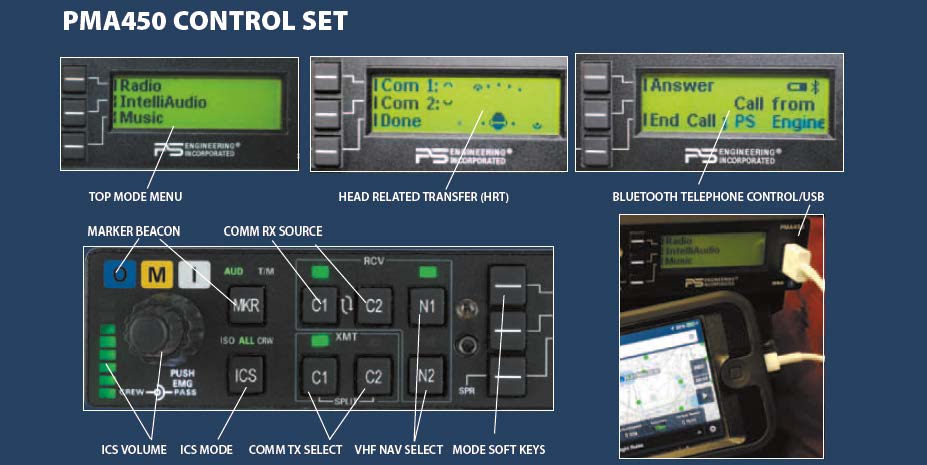An impressive trait of audio maker PS Engineering is its drive to improve and advance products that would otherwise remain cutting edge for years to come. It seems every time I evaluate one of its feature-packed audio panels, a new model with more capability comes along a year later.

This year at AirVenture, PS Engineering introduced the $2395 PMA450, a slide-in replacement for the company’s PMA8000-series audio panel. It’s a product that I thought had more than enough functionality and features—perhaps more than some pilots use.
But the PMA450 packs more than additional features. Instead, it has new digital audio processing technology that puts it on a level playing field with Garmin’s GMA350 retrofit audio system.
Intelli audio
That’s what PS Engineering calls the patented technology that it licensed from the United States Air Force. Since fighter pilots (and GA pilots, perhaps to a lesser extent) are inundated with multiple types of audio signals at once, the branded IntelliAudio—which Air Force pilots know as Multi-talker—helps present the audio sources in a way that’s more intuitive to process, or at least in a way that mimics how the human ear hears and registers sound.
IntelliAudio places Comm 1 and Comm 2 audio in various positions within the stereo headset, making simultaneous incoming radio signals sound as if they are coming from different locations.

For example, the user can place the signal sources in nine unique positions. The intent is to make it easier for the pilot to concentrate on the radio of choice while ignoring the radio of lesser importance at the time. For example, the pilot can choose to pay attention to ATC while ignoring an ATIS broadcast, depending upon what is pertinent at the moment.
This distracting situation always seems to overload my brain and if I’m listening to an ATIS broadcast on the second radio while monitoring a busy approach or tower frequency on the primary radio, I’m constantly turning the ATIS volume off when I hear activity on the primary radio, even if the call isn’t for me.
With IntelliAudio, you can place the ATIS in a different location within the headset so the brain can more easily discern one source from the other.
Visual setup
While the PMA450 brings many of the same functions found on the PMA8000 panel, there is a new user interface that utilizes a graphical display with three soft keys that PS Engineering says helps the user visualize the system setup—essentially eliminating a pilot guide. The display is LCD, which isn’t great in bright sunlight. There is a brightness and contrast adjustment, however, which helps. There’s also a menu screen timeout function, where the user can adjust how quickly the screen reverts to the main menu.
To adjust or relocate audio sources for dimensional sound, the PMA450 uses a Head Related Transfer (HRT) function that’s accessed onscreen. Press the IntelliAudio soft key, where there’s an option to turn the function on or off (you can still use the panel in a traditional configuration) and select the IntelliAudio Config option. Once in the IntelliAudio mode, repeated pressing of the Comm 1 or Comm 2 line select keys moves a corresponding half-circle cursor to the locations relative to the listener graphic that’s on the display. Press Done to exit and save the configuration, where it’s recalled at every system power up.
A comm monitoring mode takes the interface one step further by allowing the secondary radio audio to be muted by the primary radio (or the one being used for transmissions) when there’s activity. This essentially automates my process of cranking the volume down when listening to ATIS on the second radio. the bottom soft key serves double duty for speaker activation, enabling the internal speaker amplifier.
The front panel has dedicated nav receiver keys, while switched audio input sources (traffic and terrain system audio, for example) can be configured for onscreen selection, based upon the wiring. The default switched inputs are for ADF and DME audio, but the user has access to rename the inputs—up to nine letters per line.
More utility
The PMA450 brings all the failsafe, intercom and entertainment input capabilities found in the PMA8000 and the recently introduced PAR200 budget audio panel (see the September 2013 Aviation Consumer for a review). These features have been standard on PS panels and intercoms for years, so I won’t cover them here.
As I’ve found with the company’s other products, the adjustment-free IntelliVox squelch circuit is flawless. While non-voice signals are blocked, only voice activity opens the squelch.
What is new is onscreen Bluetooth telephone control and a USB plug-in. When the phone rings, an incoming call menu opens, showing caller ID. Simply answer the call by pressing the top line select soft key on the display.
The only problem is since the phone uses an intercom circuit, all stations on that circuit lose intercom capability when the phone is in use. It’s not a big problem—because do you really use a cell phone for long periods during flight?
The panel comes standard with an internal digital recorder that captures the last incoming audio from the radio that’s selected for transmit. It stores up to eight messages and up to 45 seconds of audio. Playback is simple—press and hold the comm receiver button for one second. It’s nice to see this utility as standard.
THE better way
I think PS Engineering’s Dimensional Sound IntelliAudio really is a better way of processing multiple audio signals. Frankly, I dismissed the technology when I first used Garmin’s 3D audio feature that’s present on the GMA350/35 audio panel because I found it to be overwhelming, especially when passengers are talking on the intercom.
In my estimation, PS Engineering did a good job of designing the HTRF function so that it’s easy to configure and change on the fly. When I flew with it, I positioned Comm 1 in the left side of the headset and Comm 2 on the right. It seemed to be a logical configuration, based on a standard radio stack configuration. But on panels that are nonstandard (maybe the second Comm is located on the left side of the panel), you can adjust the audio to play where you want it.
The positioning of the audio was so precise that I often forgot the audio was confined to the headset. That speaks volumes about the technology in general. Contact www.ps-engineering.com, 865-988-9800.





